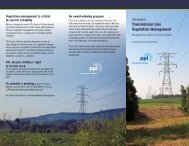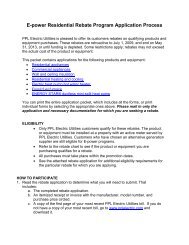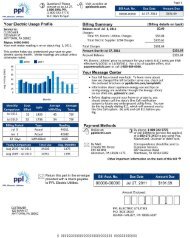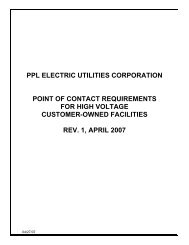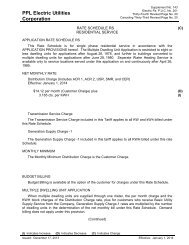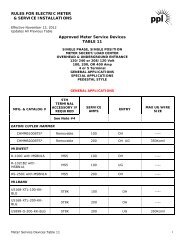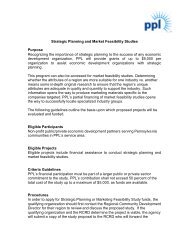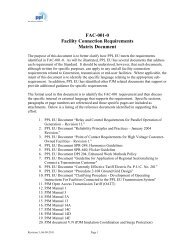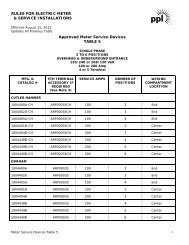brochure - PPL Electric Utilities
brochure - PPL Electric Utilities
brochure - PPL Electric Utilities
Create successful ePaper yourself
Turn your PDF publications into a flip-book with our unique Google optimized e-Paper software.
Right tree in the right place<br />
If you plan to plant a new tree, or replace an existing tree,<br />
please pay close attention to what you plant and where. When<br />
choosing a spot to plant your tree, make sure it will have plenty<br />
of room to grow to its full potential. Speak with the nursery<br />
where you plan to purchase the tree and tell them about any<br />
power lines so they can help you select the right tree.<br />
Planting the right tree for the right place will make your<br />
property safer and more attractive and will reduce the<br />
likelihood of power outages. Our professional foresters can<br />
also advise you on proper tree selection for the location you<br />
have chosen.<br />
Around your neighborhood<br />
Distribution Line<br />
Vegetation<br />
Management<br />
Keeping your electric<br />
service reliable<br />
www.pplelectric.com/vegetation<br />
<strong>PPL</strong> <strong>Electric</strong> <strong>Utilities</strong> is a<br />
Tree Line USA Utility<br />
If you have additional questions, please call<br />
<strong>PPL</strong> Vegetation Management at 1-877-528-2889<br />
or visit www.pplelectric.com/vegetation.<br />
Before trimming<br />
50M 4/13<br />
After trimming
DISTRIBUTION LINE VEGETATION MANAGEMENT<br />
KEEPING YOUR ELECTRIC SERVICE RELIABLE<br />
Our program<br />
<strong>PPL</strong> <strong>Electric</strong> <strong>Utilities</strong> operates about<br />
28,000 miles of aerial distribution lines<br />
that deliver power from local substations<br />
directly to homes and businesses.<br />
Since trees are a common cause of power outages, vegetation<br />
management is a critical part of providing safe, reliable electric<br />
service. If left unmanaged, some vegetation can grow too close<br />
to our lines and cause outages or other unsafe conditions.<br />
Tree-related outages can potentially affect thousands of<br />
customers for extended periods of time.<br />
We’ve expanded the scope of our vegetation management<br />
because our experience showed more needs to be done to help<br />
guard against tree-related outages, especially during storms.<br />
This means we are trimming more than we have in the past and<br />
removing trees when necessary. We understand this approach<br />
is not always popular, but it is the right thing to do to keep the<br />
system safe and reliable for all.<br />
To manage vegetation, our professional foresters work directly<br />
with qualified tree contractors who perform the actual work.<br />
Before any pruning or tree removal occurs, vegetation<br />
conditions are assessed with consideration to tree species,<br />
growth rates, position of the lines and time since the last<br />
vegetation work was performed.<br />
Our contractors use widely accepted industry best practices<br />
and techniques, including pruning that encourages quick and<br />
complete healing of removed branches and reduces both<br />
potential decay and growth of new sprouts. Before we begin<br />
work, we will attempt to visit your home to explain what our<br />
contractors will be doing. If no one is home, we’ll leave a door<br />
hanger with a <strong>brochure</strong> and contact information.<br />
Our pledge to you<br />
We understand that removing or trimming trees may not be<br />
popular with many landowners.<br />
• We pledge to communicate with property owners<br />
in advance of regularly scheduled vegetation work.<br />
• We pledge to work in a professional manner.<br />
• We pledge to treat private property with care.<br />
• We pledge to strike a careful balance — being sensitive<br />
to individual landowner concerns about vegetation<br />
management while, at the same time, doing the work<br />
that is needed to improve electric service reliability for<br />
all customers by keeping trees away from power lines.<br />
Cleanup and wood chips<br />
In urban areas, tree crews typically chip and remove smaller limbs<br />
and branches. Larger wood is generally cut into handling lengths<br />
and left at the base of the tree for property owner use.<br />
In more rural areas, where possible, tree crews will pile pruning<br />
debris to create wildlife cover and browse opportunities. Larger<br />
limb wood will be separated and left for property owner use.<br />
Requests for wood chips are taken by the contractor tree crew<br />
foremen who do their best to grant your requests. If you do<br />
request chips, be mindful that contractors will deliver full loads –<br />
5 to 7 cubic yards. Contractors are not required to remove unused<br />
chips once delivered.<br />
Don’t endanger yourself<br />
Please do not attempt<br />
to prune or remove<br />
trees near power lines.<br />
Contact with a power line<br />
can cause serious injury<br />
or death. <strong>PPL</strong> <strong>Electric</strong><br />
<strong>Utilities</strong>’ qualified line<br />
clearance tree trimmers<br />
have specialized training<br />
to work around our<br />
power lines.<br />
If you, or a private arborist working for you, plan to trim or remove<br />
a tree growing less than 10 feet from a power line, call <strong>PPL</strong> <strong>Electric</strong><br />
<strong>Utilities</strong>. We will have one of our tree trimmers prune the tree to<br />
provide a safe working distance.<br />
<strong>PPL</strong> <strong>Electric</strong> <strong>Utilities</strong> does not prune or remove trees located<br />
around the service wire that is between your house and the pole.<br />
<strong>PPL</strong> <strong>Electric</strong> <strong>Utilities</strong> will de-energize your service wire and lower<br />
it to the ground so you can do the work safely.<br />
Both of these services are provided at no cost, but we require<br />
at least three business days’ notice, and additional time may be<br />
required to schedule the work.




